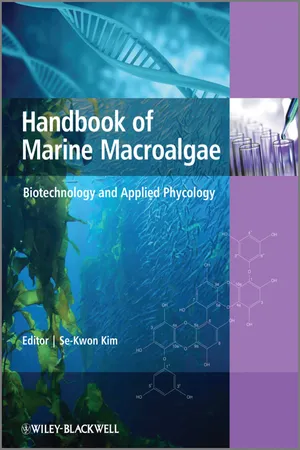
- English
- ePUB (mobile friendly)
- Available on iOS & Android
eBook - ePub
About this book
The Handbook of Macroalgae: Biotechnology and Applied Phycology describes the biological, biotechnological and the industrial applications of seaweeds. Vast research into the cultivation of seaweeds is currently being undertaken but there is a lack of methodological strategies in place to develop novel drugs from these sources. This book aims to rectify this situation, providing an important review of recent advances and potential new applications for macroalgae. Focusing on the chemical and structural nature of seaweeds the book brings the potentially valuable bioactive nature to the fore. Novel compounds isolated from seaweeds are reviewed to provide an invaluable reference for anyone working in the field.
Frequently asked questions
Yes, you can cancel anytime from the Subscription tab in your account settings on the Perlego website. Your subscription will stay active until the end of your current billing period. Learn how to cancel your subscription.
No, books cannot be downloaded as external files, such as PDFs, for use outside of Perlego. However, you can download books within the Perlego app for offline reading on mobile or tablet. Learn more here.
Perlego offers two plans: Essential and Complete
- Essential is ideal for learners and professionals who enjoy exploring a wide range of subjects. Access the Essential Library with 800,000+ trusted titles and best-sellers across business, personal growth, and the humanities. Includes unlimited reading time and Standard Read Aloud voice.
- Complete: Perfect for advanced learners and researchers needing full, unrestricted access. Unlock 1.4M+ books across hundreds of subjects, including academic and specialized titles. The Complete Plan also includes advanced features like Premium Read Aloud and Research Assistant.
We are an online textbook subscription service, where you can get access to an entire online library for less than the price of a single book per month. With over 1 million books across 1000+ topics, we’ve got you covered! Learn more here.
Look out for the read-aloud symbol on your next book to see if you can listen to it. The read-aloud tool reads text aloud for you, highlighting the text as it is being read. You can pause it, speed it up and slow it down. Learn more here.
Yes! You can use the Perlego app on both iOS or Android devices to read anytime, anywhere — even offline. Perfect for commutes or when you’re on the go.
Please note we cannot support devices running on iOS 13 and Android 7 or earlier. Learn more about using the app.
Please note we cannot support devices running on iOS 13 and Android 7 or earlier. Learn more about using the app.
Yes, you can access Handbook of Marine Macroalgae by Se-Kwon Kim in PDF and/or ePUB format, as well as other popular books in Biological Sciences & Marine Biology. We have over one million books available in our catalogue for you to explore.
Information
PART I
Introduction to Algae and Their Importance
1
Biological Importance of Marine Algae
1.1 Introduction
Marine organisms are potentially productive sources of highly bioactive secondary metabolites that might represent useful leads in the development of new pharmaceutical agents (Iwamoto et al. 1998, 1999, 2001). During the last four decades, numerous novel compounds have been isolated from marine organisms and many of these substances have been demonstrated to possess interesting biological activities (Faulkner, 1984a,b, 1986, 1987, 1988, 1990, 1991, 1992, 1993, 1994, 1995, 1995, 1996, 1997, 1998, 1999, 2000, 2001, 2002).
Algae are very simple, chlorophyll-containing organisms (Bold and Wynne, 1985) composed of one cell or grouped together in colonies or as organisms with many cells, sometimes collaborating together as simple tissues. They vary greatly in size – unicellular of 3–10 μm to giant kelps up to 70 m long and growing at up to 50 cm per day (Hillison, 1977). Algae are found everywhere on Earth: in the sea, rivers and lakes, on soil and walls, in animal and plants (as symbionts-partners collaborating together); in fact just about everywhere where there is a light to carry out photosynthesis.
Algae are a heterogeneous group of plants with a long fossil history. Two major types of algae can be identified: the macroalgae (seaweeds) occupy the littoral zone, which included green algae, brown algae, and red algae, and the microalgae are found in both benthic and littoral habitats and also throughout the ocean waters as phytoplankton (Garson, 1989). Phytoplankton comprise organisms such as diatoms (Bacillariophyta), dinoflagellates (Dinophyta), green and yellow-brown flagellates (Chlorophyta; Prasinophyta; Prymnesiophyta, Cryptophyta, Chrysophyta and Rhaphidiophyta) and blue-green algae (Cyanophyta). As photosynthetic organisms, this group plays a key role in the productivity of oceans and constitutes the basis of the marine food chain (Bold and Wynne, 1985; Hillison, 1977).
The true origins of compounds found in marine invertebrates have been a subject of discussion. They may vary from compound to another, but there are strong hints that dietary or symbiotic algae are one of the participants in the production of these metabolites. For example, as early as 1977, the blue-green algae, Lyngbya majusula was recognized as the source of aplysiatoxin 1 found in the sea hares Aplysia that feed on this alga (Mynderse et al., 1997). Similarly, a series of highly active antitumor compounds, dolastatin 2 and 3, isolated from sea slugs are considered to be of blue-green algal origin (Shimizu, 2000). Also, eukaryotic algae and various dinoflagellate metabolites are found in shellfish and other invertebrates as toxins (Shimizu, 2000). Brevetoxins 4, ciguatoxins 5, and dinophysistoxins-1&2 and 6 and 7 are well known examples of paralytic shellfish toxins (Hall and Strichartz, 1990).
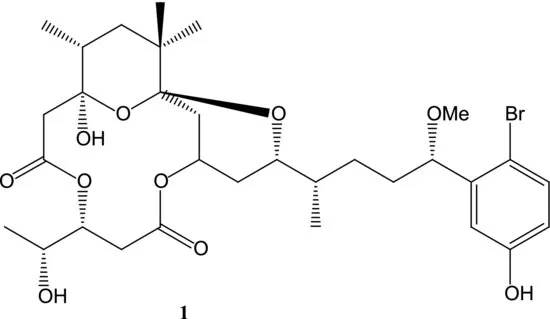
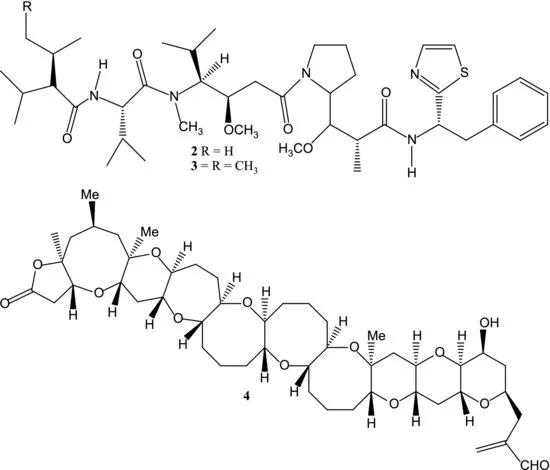
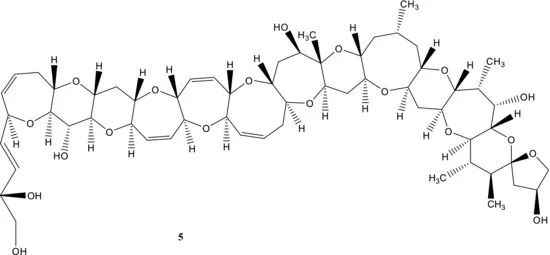
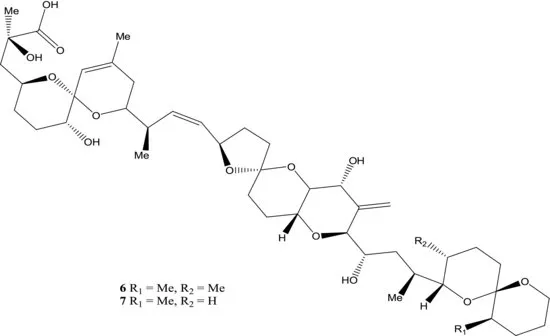
1.2 Interesting natural products and their biological activities from macroalgae (seaweeds)
Marine macroalgae or seaweeds have been used as foods especially in China and Japan and crude drugs for treatment of many diseases such as iodine deficiency (goiter, Basedow's disease and hyperthyroidism). Some seaweeds have also been used as a source of additional vitamins, treatment of various intestinal disorders, as vermifuges, and as hypocholesterolemic and hypoglycemic agents. Seaweeds have been employed as dressings, ointments and in gynecology (Trease and Evanes, 1996).
Macroalgae can be classified into three classes: green algae (Chlorophyta), brown algae (Phaeophyta) and red algae (Rhodophyta) (Garson, 1989).
1.2.1 Chlorophyta (green algae)
The characteristic green color of green algae is mainly due to the presence of chlorophyl a and b in the same proportion like higher plants (Bold and Wynne, 1985). There are few reports of novel secondary metabolites among the Chlorophyta than the other algal division; the following are the most important biologically active natural products isolated from these algae.
Anti-inflammatory substances
An anti-inflammatory, 3–0-β-D-glucopyranosylstigmasta-5,25-diene 8 have been isolated by Awad in 2000 (Awad, 2000) from the green alga Ulva lactuca.

Habu is a deadly snake found in Okinawa where 200–300 people are bitten by the snake every year. A patient must be given immediate medical treatment with the serum prepared from a horse-developed antibody by injection of snake toxin. However, about 20% of the patients are allergic to the serum.
In order to develop an alternative drug, Okinawa Prefectural Institute of Public Health has been conducting screening strategies to find a compound with anti-inflammatory activity, which can be measured by the suppression of inflammation caused by the injection of toxin into a mouse limb. A diphenyl ether 9 isolated from an alga was found to be effective in this assay (Higa, 1989). The extract of the green alga Cladophora fascicularis was separated by different chromatographic methods to produce 2-(2′,4′ dibromophenoxy)-4,6-dibromoanisol (Kuniyoshi, Yamada and Higa, 1985), the first example of diphenyl ether from green algae. It was also active in inhibiting the growth of Escherichia coli, Bacillus subtilis and Staphylococcus aureus (Kuniyoshi, Yamada and Higa, 1985).
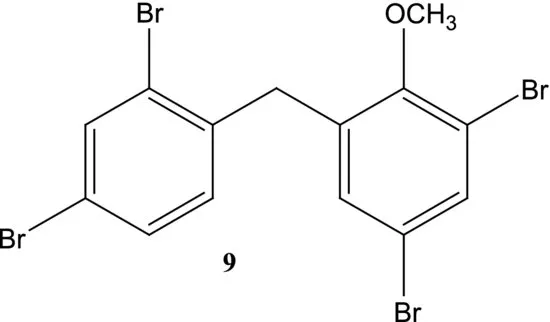
Cytotoxic and immunosuppressive activities
Bioassay-guided fractionation utilizing inhibitory activity against inosine -5′-monophosphate dehydrogenase inhibitor (IMPDH) leads to the isolation of a new brominated diphenylmethane derivative. Isorawsonol 10 was isolated from the tropical green alga Arrainvilla rawsonii by Chen and colleagues in 1994 (Chen et al., 1994). The activity of IMPDH has been linked with cellular proliferation and inhibition of that enzyme has been demonstrated to have anticancer and immunosuppressive effects (Chen et al., 1994).

Bioactivity-directed fractionation of the extract of the green alga Tydemania expeditionis using the protein tyrosine kinase pp60v-stc led to the isolation of three new cycloartenol disulfates 11–13; they showed modest inhibition of this enzyme (Govindan et al., 1994).
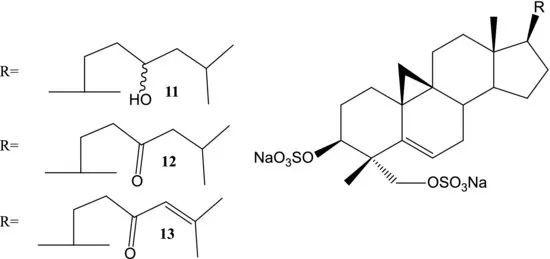
Communesins A 14 and B 15, exhibiting cytotoxic activity against cultured P-388 lymphocytic leukemia cells, were isolated from the mycelium of a strain of Penicillium species stuck on the marine alga Enteromorpha intestinalis (Numata et al., 1993).
Penostatins A 16, B 17, C 18, D 19 (Takahashi et al., 1996) and E 20 (Iwamoto et al., 1999) have been isolated from a strain of Penicillium species originally separated from the marine alga Enteromorpha intestinalis (L.) Link (Ulvaceae). The compounds A–C and E exhibited significant cytotoxicity against the cultured P388 cell line (Iwamoto et al., 1999; Takahashi et al., 1996). Penostatins F, G, H 21–23 and I 24 were isolated from a strain of Penicillium originally separated from the marine alga Enteromorpha intestinalis (L.) Link (Ulvaceae). All the compounds exhibit significant cytotoxicity against cultured P388 cells (Iwamoto et al., 1998).

The novel compounds cytochalasins, penochalasins A–C 25–27 (Numata et al., 1996), D–H 28–32, and chaetoglobosin O 33 (Iwamoto et al., 2001) were isolated from a strain of Penicillium species originally separated from the marine alga Enteromorpha intestinalis. All these compounds exhibited potent cytotoxic activity against cultured P388 cells.
Four new diterpenoid metabolites were isolated from several species of the green algae Halimeda (Udoteaceae). These new compounds show potent antimicrobial and cytotoxic properties in bioassays. Among these four compounds were halimediatrial 34 and halimedalactone 35 (Paul and Fenical, 1983). Halimedatrial 34 is a diterpene trialdehyde that was extracted from Halmida lamouroux (Chlorophyta, Udoteaceae) species. This comp...
Table of contents
- Cover
- Title Page
- Copyright
- Contributors
- Preface
- Editor
- Part I: Introduction to Algae and Their Importance
- Part II: Isolation and Chemical Properties of Molecules Derived from Seaweeds
- Part III: Biological Properties of Molecules Derived from Seaweeds
- Part IV: Biotechnology of Seaweeds
- Part V: Natural Resource Management and Industrial Applications of Seaweeds
- Index